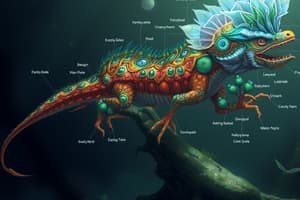Podcast
Questions and Answers
What characterizes the genus in biological classification?
What characterizes the genus in biological classification?
- It can include several species. (correct)
- It includes only one species.
- Its first letter is always lowercase.
- It can never be used alone.
Which of the following statements about species is true?
Which of the following statements about species is true?
- Species names are always capitalized.
- Species names can be used independently.
- Species can never be used alone. (correct)
- Species can exist within multiple genera.
How do dichotomous keys assist ecologists?
How do dichotomous keys assist ecologists?
- They use DNA sequences for classification.
- They classify organisms based on geographical location.
- They group organisms by their ancestral history.
- They utilize visible characteristics for identification. (correct)
What recent discovery has affected the classification of skunks?
What recent discovery has affected the classification of skunks?
What is indicated by binomial nomenclature?
What is indicated by binomial nomenclature?
What is taxonomy?
What is taxonomy?
Which domain includes organisms with prokaryotic cells and lives in extreme environments?
Which domain includes organisms with prokaryotic cells and lives in extreme environments?
What is the order of classification from general to specific?
What is the order of classification from general to specific?
What does the genus name represent in binomial nomenclature?
What does the genus name represent in binomial nomenclature?
How are scientific names formatted in binomial nomenclature?
How are scientific names formatted in binomial nomenclature?
Which of the following is an example of an organism classified under the domain Eukarya?
Which of the following is an example of an organism classified under the domain Eukarya?
In binomial nomenclature, what does 'Castor canadensis' represent?
In binomial nomenclature, what does 'Castor canadensis' represent?
Which level of classification comes directly after 'Family'?
Which level of classification comes directly after 'Family'?
Flashcards
Genus
Genus
A taxonomic group that can contain multiple species. Always capitalised.
Species
Species
A taxonomic group that cannot stand alone; needs a genus to be properly identified.
Binomial Nomenclature
Binomial Nomenclature
A system for naming organisms using two names (genus and species).
Dichotomous Key
Dichotomous Key
Signup and view all the flashcards
Classification changes
Classification changes
Signup and view all the flashcards
Taxonomy
Taxonomy
Signup and view all the flashcards
Domains of Life
Domains of Life
Signup and view all the flashcards
Archaea
Archaea
Signup and view all the flashcards
Bacteria
Bacteria
Signup and view all the flashcards
Eukarya
Eukarya
Signup and view all the flashcards
Study Notes
B2 - Classifying and Naming Organisms
- Ecologists use taxonomy to consistently classify species and their relatives, crucial for discussing population distribution and diversity.
- Taxonomy is the practice of classifying living things.
I Can...
- Explain fundamental principles of taxonomy and binomial nomenclature.
Classifying Organisms
- All living organisms are classified into three domains: Archaea, Bacteria, and Eukarya.
- Archaea: Ancient bacteria, often living in extreme environments.
- Bacteria: Bacteria not classified as Archaea, found in various environments.
- Eukarya: Eukaryotic organisms (with nuclei), encompassing a broader range of life forms, including plants, animals, and fungi.
Domains of Life
- Archaea: Prokaryotic cells (no nucleus), single-celled organisms, live in extreme environments (e.g., heat, pH, salinity). Can be autotrophs or heterotrophs. Examples include halophiles and methanophiles.
- Bacteria: Prokaryotic cells (no nucleus), single-celled organisms, live in less extreme environments. Can be autotrophs or heterotrophs. Examples include cyanobacteria and E. coli.
- Eukarya: Eukaryotic cells (with nucleus), single-celled or multicellular organisms, live in less extreme environments. Can be autotrophs or heterotrophs. Examples include plants, animals, protists, and fungi.
Classifying Organisms (Levels of Classification)
- A system of eight levels classifying organisms from general to specific.
-
- Domain
-
- Kingdom
-
- Phylum
-
- Class
-
- Order
-
- Family
-
- Genus
-
- Species.
- This system, excluding domain, was developed by Carolus Linnaeus.
Example: Bobcats
- Showing the classification of bobcats to highlight their relationships with other organisms.
- Bobcats are classified within the domain Eukarya, kingdom Animalia, and so on.
Naming Systems
- Most organisms are classified using binomial nomenclature.
- Binomial nomenclature is a two-part naming system using genus and species names.
- Examples include Homo sapiens (humans), Rana tigrina (a type of frog), and Pisum sativum (peas).
- Scientific names are italicized and use Latin or Greek words.
Binomial Nomenclature (Special Rules)
- Genus: Includes several species, capitalized first letter, can be written alone.
- Species: Never written alone; lowercased.
Binomial Nomenclature
- Organisms with similar anatomy, embryology, and evolutionary history are more closely related.
- For example, grizzly, Alaskan brown, and polar bears all belong to genus Ursus, suggesting a relationship.
Changing Names
- DNA sequencing allows scientists to verify organism classification.
- Skunks, for example, have been reclassified, suggesting newer knowledge based on DNA analysis.
Dichotomous Keys
- Dichotomous keys guide identification of organisms using a series of paired descriptors.
- An easy method of sorting organisms based on their visual characteristics.
- Used in taxonomy to make classification more efficient.
- Examples of dichotomous keys to identify flowers and leaves.
Studying That Suits You
Use AI to generate personalized quizzes and flashcards to suit your learning preferences.




